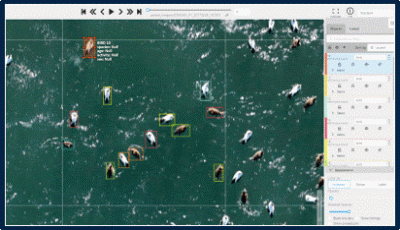As energy development increases along the Atlantic Coast and across the Outer Continental Shelf (OCS), BOEM needs robust species and site-specific information on the seasonal distribution and abundance of marine species – including seabirds, marine mammals and turtles – that could be affected by offshore energy activities.
When it comes to identifying and counting multiple species on marine wildlife aerial surveys, observer accuracy can vary widely. BOEM intends to improve the detection and classification of species recorded on aerial surveys through the Atlantic Marine Assessment Program for Protected Species (AMAPPS) III project.
The U.S. Fish and Wildlife Service (USFWS) are conducting aerial surveys in BOEM-identified target areas to capture high-resolution images of marine mammals, sea turtles and seabirds to build a database of annotated photos. The database will train deep learning computer vision algorithms to count and identify the species and – once trained – deep learning models will automatically detect and count species in new images. BOEM will compare the accuracy of species identification using high-resolution imagery with previous AMAPPS observer-based data to quantify the performance of both methods.
AMAPPS III builds on a decade of AMAPPS observer-based aerial surveys conducted by the USFWS. From 2010–2019 the USFWS, in coordination with BOEM, has conducted systematic high fixed-wing aerial surveys from Florida to Maine, focused on seabirds, sea turtles, and marine mammals.
For more information: https://www.boem.gov/AT-20-02
-- BOEM --
The Department of the Interior’s Bureau of Ocean Energy Management (BOEM) is responsible for America’s offshore energy and mineral resources. The bureau promotes energy independence, environmental protection and economic development through responsible, science-based management of energy and mineral resources on the U.S. Outer Continental Shelf.


